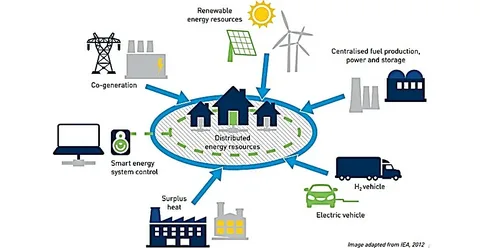Distributed Energy Resource Management Market: Smart Grids and Renewables

Introduction
Distributed Energy Resource Management Systems (DERMS) are software platforms that optimize, control, and integrate distributed energy resources (DERs) such as rooftop solar, wind turbines, battery storage, electric vehicles, and demand response systems into the electric grid. DERMS enable utilities to manage distributed generation efficiently, maintain grid stability, and maximize renewable energy utilization. With rising renewable adoption, energy decentralization, and digitalization, DERMS are becoming essential tools for modern grids, microgrids, and smart cities.
Market Dynamics (Drivers, Challenges, Opportunities)
Drivers:
The growing adoption of distributed renewable energy assets is a major driver. Utilities are challenged to balance intermittent generation while avoiding overloads, voltage fluctuations, and congestion. DERMS provide real-time visibility and control, facilitating grid stability. Policy support for decarbonization, net-zero targets, and smart city initiatives also propels market growth. Additionally, integration of electric vehicles and battery storage into grids requires intelligent orchestration, which DERMS provide.
Challenges:
Complexity in integrating diverse DER assets, interoperability issues among equipment and software, and high initial investment costs hinder adoption. Data security and cybersecurity risks, coupled with the need for skilled personnel to manage sophisticated systems, remain key barriers. Regulatory variations across regions can also slow DERMS deployment.
Opportunities:
DERMS offer opportunities in grid modernization, microgrids, demand response, and virtual power plants (VPPs). The platform can also enable monetization of excess distributed generation and participation in ancillary service markets. Combining DERMS with advanced analytics, AI, and IoT devices improves predictive maintenance, energy efficiency, and automated demand response, opening additional revenue streams for utilities.
Market Segmentation
By Component:
- Hardware (controllers, sensors, meters)
- Software (energy management platforms, analytics)
- Services (consulting, integration, maintenance)
By End-User:
- Utilities & Grid Operators
- Microgrids
- Commercial & Industrial Facilities
- Residential Communities
By Region:
- North America
- Europe
- Asia-Pacific
- Middle East & Africa
- Latin America
Regional Analysis
North America leads due to high penetration of DERs, favorable regulations, and utility-driven smart grid projects. Europe focuses on renewable integration and decarbonization with DERMS-enabled virtual power plants. Asia-Pacific is growing rapidly, driven by energy access expansion, urbanization, and renewable adoption in countries like China, Japan, and India. Middle East & Africa presents selective opportunities in industrial microgrids and renewable-based energy projects, while Latin America is exploring DERMS to optimize distributed generation and industrial power usage.
Key Trends
- Virtual Power Plants (VPPs): Aggregating DERs for energy trading and grid services.
- Integration with IoT and AI: Real-time analytics and predictive management.
- Hybrid Energy Systems: Coordinating DERs with battery storage and renewable generation.
- Demand Response Management: Incentivizing consumption flexibility to optimize grid operation.
- Cybersecurity Measures: Enhancing reliability and trust in digital energy platforms.
Future Outlook
DERMS adoption is expected to grow substantially over the next decade as renewable penetration and electrification increase. Utilities and energy service companies will continue investing in intelligent control systems to optimize distributed assets. Technological advancements in cloud-based DERMS, AI, and IoT-enabled devices will enhance operational efficiency, grid resilience, and renewable integration.
Conclusion
Distributed Energy Resource Management Systems are key enablers for the transition to a decentralized, smart, and sustainable energy ecosystem. By offering real-time control, analytics, and automation for distributed energy assets, DERMS empower utilities and industries to balance energy demand, integrate renewables, and maintain grid stability.
- Art
- Causes
- Crafts
- Dance
- Drinks
- Film
- Fitness
- Food
- Games
- Gardening
- Health
- Home
- Literature
- Music
- Networking
- Other
- Party
- Religion
- Shopping
- Sports
- Theater
- Wellness
